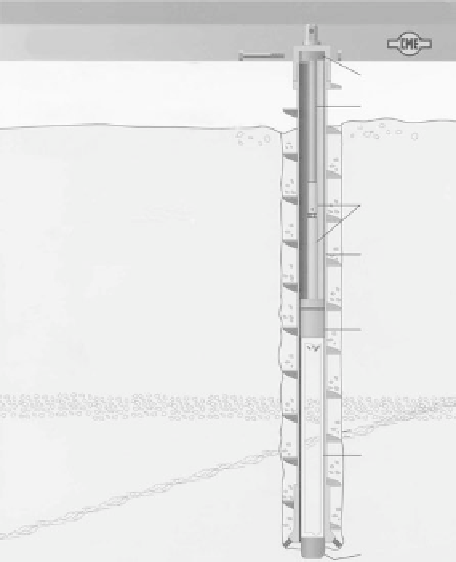Environmental Engineering Reference
In-Depth Information
CME
Bearing Head
Continuous Sample
Tube System
Rod to cap
adapter
Drill rod
Adjustment Rod
Hollow-stem
auger
Bearing
Assembly
Sample tube
Sample shoe
Figure 5.13.
Hollow auger continuous sample tube system (courtesy CMEC).
bailer. If the hole is dry, water is added to aid the bailing. As the hole is advanced steel
casing is driven to preserve the hole. The method is slow, but is effective in penetrat-
ing gravels. It should be appreciated that the penetration process involves a reduction
in particle size and may mix material from several layers. The grading of samples
recovered from cable tool drilling may be different from that of the natural material.
(b)
Cable-tool Tube (also called Shell and Auger) drilling
. This method described by
Wilson and Hancock (1970) uses a cable-tool rig as in
Figure 5.14a
but the hole is
advanced and sampled by driving 100 mm diameter sampling tubes (Figure 5.14b and
Figure 5.15
). After each 300 mm long tube is driven the sample is extruded into a plas-
tic sleeve, labelled and placed into a core tray. Before the next sample is taken the hole
is reamed out using a slightly belled cutting shoe. When required, due to hole collapse
or to seal off groundwater flow, the hole is reamed further and casing is driven. No
drilling fluid is required. The method provides a continuous geological record in most
soil types, a record of moisture content changes and also of the position and source
level of any groundwater inflows (Figure 5.15). The tube samples are too disturbed
for triaxial or similar testing but the fabric and defects in soils are preserved and can
be seen when the samples are split. If rock, coarse gravel or boulders are met, these
materials can be penetrated by the bit and bailer method.
Cable-tool drilling can be used for investigating the cores of existing dams as it is a dry
method and will not induce hydraulic fracture. However it is slow and expensive com-
pared to auger drilling. Completion of such holes should include backfilling with
grout in stages designed to avoid hydraulic fracture.
(c)
Hammer (or Impact) Drilling.
Machines for this type of drilling range from the very small
“air-tracks” through larger versions to large truck-mounted downhole hammers with


